Study on the Provenance and Tectonic Setting of Mudstone in the Lower Silurian Longmaxi Formation of the Yanyuan Basin on the Western Margin of the Yangtze Platform
Abstract
:1. Introduction
2. Geological Setting
3. Samples and Methods
4. Analytical Results
4.1. Petromineralogical Characteristics
4.2. Geochemical Characteristics
5. Discussion
5.1. Rock Types in the Provenance Area
5.2. Provenance Weathering
5.3. Tectonic Background
5.4. Sedimentary Tectonic Evolution Model and Its Geological Significance
6. Conclusions
- The black shale in the study area has a high siliceous content and biosiliceous features such as radiolaria and spongy bone needles. A large number of graptolites and porphyritic interlayers are observed. Black shale has complex parent rock types and mixed origins that consist mainly of acidic felsic igneous rocks, with minor contributions from admixed intermediate–basic rocks. It is speculated that the parent rock was mainly provided by the Archean crystalline basement of the Kangdian ancient land in the eastern part of the study area, together with a small amount of deep-sea and island arc materials from the western ocean.
- In the early Longmaxi period, the study area inherited the cold climate of the late Ordovician glacial period, and the chemical weathering was weak. In the late Longmaxi period, the climate gradually warmed, and chemical weathering was enhanced. During the whole Longmaxi period, the tectonic movement was intense, physical weathering was the main action, and the clastic sedimentary was the initial sedimentation under the active tectonic environment.
- The western margin of the Yangtze platform continued to uplift during the Longmaxi period, as part of a passive continental margin environment, but the tectonic activity in the study area was obviously strong, and the source rock showed the attributes of an active continental margin and island arc environment. It is speculated that this may be related to the collision between the western oceanic crust and the Yangtze continental crust; mantle sources or deep-sea materials were deposited due to volcanism and hydrothermal or rising ocean currents, which caused the black shale to retain the geochemical composition of the active continental margin and island arc tectonic background.
Author Contributions
Funding
Acknowledgments
Conflicts of Interest
References
- Zou, C.; Zhao, Q.; Cong, L.; Wang, H.; Shi, Z.; Wu, J.; Pan, S. Development progress, potential and prospect of shale gas in China. J. Nat. Gas Ind. 2021, 41, 1–14, (In Chinese with English Abstract). [Google Scholar]
- Zhang, J.; Shi, M.; Wang, D.; Tong, Z.; Hou, X.; Niu, J.; Li, X.; Li, Z.; Zhang, P.; Huang, Y. Fields and directions for shale gas exploration in China. J. Nat. Gas Ind. 2021, 41, 12–22, (In Chinese with English Abstract). [Google Scholar] [CrossRef]
- Dong, D.; Liang, F.; Guan, Q.; Jiang, Y.; Zhou, S.; Yu, R.; Gu, Y.; Zhang, S.; Qi, L.; Liu, Y. Development model and identification evaluation technolo-gy of WufengLongmaxi Formation quality shale gas reservoirs in the Sichuan Basin. J. Nat. Gas Ind. 2022, 42, 96–111, (In Chinese with English Abstract). [Google Scholar]
- Zhang, Q.; Wang, J.; Yu, Q.; Wang, X.; Zhao, A.; Zhang, H.; Wang, Z. Black shales from the Longmaxi Formation in western Xikang-Yunnan ancient land: Geochemistry and geological implications. J. Sediment. Geol. Tethyan Geol. 2017, 37, 97–107, (In Chinese with English Abstract). [Google Scholar]
- Wang, Z.; Deng, M.; Cheng, J.; Zhang, H. Influence of fault and magmatism on oil and gas preservation condition to the west of Kangdian cncient continent. Taking Yanyuan basin as an example. J. Earth Sci. 2018, 43, 286–294, (In Chinese with English Abstract). [Google Scholar]
- Zhang, Q.; Wang, J.; Yu, Q.; Xiao, Y.; Zhang, B.; Wang, X.; Zhao, A. The Silicon Source and Sedimentary Environment of the Lower Silurian Longmaxi Formation in Yanyuan Basin, Western Edge of the Yangtze Platform. Geol. Rev. 2018, 64, 610–622, (In Chinese with English Abstract). [Google Scholar]
- Cheng, J.; Deng, M.; Wang, Z.; Yu, Q.; Zhang, H.; Liu, W.; Zhao, A.; Yang, G. Paleo-marine redox conditions and development model of high-quality source rocks of the Early Silurian on the West side of Kangdian Oldland: A case study of CYD2 well in Yanyuan area. J. Geol. Bull. China 2022, 41, 1813–1823. [Google Scholar]
- Zhu, M.; Chen, H.; Zhou, J.; Yang, S. Provenance of early Triassic in Yanyuan basin upper Yangtze and its im-plication for the tectonic evolution. J. Earth Sci. 2016, 41, 1309–1321, (In Chinese with English Abstract). [Google Scholar]
- Hu, S.; Guo, W. Rhombohedral structure framework and its junction structure style in Ninglang area of Yun nan. J. Mineral. Petrol. 1995, 15, 93–99, (In Chinese with English Abstract). [Google Scholar]
- Zhang, Q.; Xiao, Y.; Wang, X.; Yu, Q.; Wang, J.; Zhao, A.; Men, Y.; Zhou, Y. Geochemistry of the Longmaxi Formation mudstones of the southwest Sichuan Basin: Implications for provenance and source weathering. J. Geol. Rev. 2020, 66, 1393–1403, (In Chinese with English Abstract). [Google Scholar]
- Zhang, J.; Mou, C.; Zhou, K.; Feng, L.; Wu, H.; Chen, X. Geochemical characteristic of sandstones from the Mangbang formation in the Husa basin, Wstern Yunnan and its constraints on provenances and tectonic setting. J. Acta Geol. Sinaca 2017, 91, 1083–1096, (In Chinese with English Abstract). [Google Scholar]
- Liu, B.; Wang, X. Geochemistry of early paleozoic sedimentary rocks in the middle-lower reaches of the Yangtze river and its constrains on tectonic setting and provenance. J. Geotecton. Metallog. 2018, 42, 163–176, (In Chinese with English Abstract). [Google Scholar]
- Taylor, S.R.; Mclennan, S.M. The Continental Crust: Its Composition and Evolution. J. Geol. 1985, 94, 57–72. [Google Scholar]
- Sensarma, S.; Rajamani, V.; Tripathi, J.K. Petrography and Geochemical Characteristics of the Sediments of the Small River Hemavati, Southern India: Implications for Provenance and Weathering Processes. J. Sediment. Geol. 2008, 205, 111–125. [Google Scholar] [CrossRef]
- Marchig, V.H.; Gundlach, P.; Mller, P.; Schley, F. Some Geochemical Indicators for Discrimination Between Diagenetic and Hydrothermal Metalliferous Sediments. J. Mar. Geol. Deep. Sea Res. Part B Oceanogr. Lit. Rev. 1982, 50, 241–256. [Google Scholar] [CrossRef]
- Moradi, A.V.; Sari, A.; Akkaya, P. Geochemistry of the Miocene Oil Shale (Hanili Formation) in the Ankr-Orum Basin, Central Turkey: Implications for Paleoclimate Conditions, Source–Area Weathering, Provenance and Tectonic Setting. J. Sediment. Geol. 2016, 341, 289–303. [Google Scholar] [CrossRef]
- Zhang, Q.; Men, Y.; Yu, Q.; Wang, G.; Xiao, Y.; Zhang, H.; Zhao, A.; Zhou, Y.; Cao, J. Characteristics and Enrichment Genesis of the Platinum Group Elements (PGEs) in Organic Rich Shale of Wufeng and Longmaxi Formations of Upper Ordovician and Lower Silurian in the Sichuan Basin. J. Miner. 2022, 12, 1363. [Google Scholar] [CrossRef]
- Haskin, L.A.; Wildeman, T.R.; Haskin, M.A. Accurate Procedure for the Determination of the Rare Earths by Neu-tron Activation. J. Radioanal. Chem. 1968, 1, 337–348. [Google Scholar] [CrossRef]
- Roser, B.P.; Korsch, R.J. Provenance Signatures of Sandstone-Mudstone Suites Determined Using Discriminant Function Analysis of Major-Element Data. J. Chem. Geol. 1988, 67, 119–139. [Google Scholar] [CrossRef]
- Fedo, C.M.; Nesbitt, H.W.; Young, G.M. Unraveling the Effects of Potassium Metasomatism in Sedimentary Rocks and Paleosols, with Implications for Paleoweathering Conditions and Provenance. J. Geol. 1995, 23, 921–924. [Google Scholar] [CrossRef]
- Nesbitt, H.W.; Young, G.M. Petrogenesis of Sediments in the Absence of Chemical Weathering: Effects of Abra-sion and Sorting On Bulk Composition and Mineralogy. J. Sediment. 2010, 43, 715–717. [Google Scholar] [CrossRef]
- Mclennan, S.M.; Taylor, S.R. Sedimentary Rocks and Crustal Evolution: Tectonic Setting and Secular Trends. J. Geol. 1991, 99, 1–21. [Google Scholar] [CrossRef]
- Cullers, R.L. The Geochemistry of Shales, Siltstones and Sandstones of Pennsylvanian–Permian Age, Colorado, Usa: Implications for Provenance and Metamorphic Studies–Sciencedirect. J. Lithos 2000, 51, 1–203. [Google Scholar] [CrossRef]
- Du, Y.; Zhu, J.; Gu, S.; Xu, Y.; Yang, J. Sedimentary geochemical characteristics of Cambrian–ordovician siliceous rocks in the northern qilian orogenic belt and their implications for multi-island oceans. J. Sci. China Ser. D Earth Sci. 2007, 37, 1314–1329, (In Chinese with English Abstract). [Google Scholar]
- Zhang, Q.; Yu, Q.; Wang, J.; Xiao, Y.; Cheng, J.; Zhao, A.; Zhang, B. Application of ICP-MS to study the Rare Earth Element characteristics and sedimentary environment of black shale in the Longmaxi formation in the Southwestern Si-chuan Basin. J. Rock Miner. Anal. 2018, 37, 217–224, (In Chinese with English Abstract). [Google Scholar]
- Gromet, L.P.; Haskin, L.A.; Korotev, R.L.; Dymek, R.F. The North American Shale Composite: Its Compilation, Major and Trace Element Characteristics. J. Geochim. Cosmochim. Acta 1984, 48, 2469–2482. [Google Scholar] [CrossRef]
- Gadd, M.G.; Peter, J.M.; Jackson, S.E.; Yang, Z.; Petts, D. Platinum, Pd, Mo, Au and Re Deportment in Hy-per-Enriched Black Shale Ni-Zn-Mo-Pge Mineralization, Peel River, Yukon, Canada. J. Ore Geol. Rev. 2019, 107, 600–614. [Google Scholar] [CrossRef]
- Bai, Y.; Liu, Z.; Sun, P.; Liu, R.; Hu, X.; Zhao, H.; Xu, Y. Rare Earth and Major Element Geochemistry of Eocene Fi-ne-Grained Sediments in Oil Shale- And Coal-Bearing Layers of the Meihe Basin, Northeast China. J. Asian Earth Sci. 2015, 97, 89–101. [Google Scholar] [CrossRef]
- Fedo, C.M.; Young, G.M.; Nesbitt, H.W. Paleoclimatic Control On the Composition of the Paleoproterozoic Serpent Formation, Huronian Supergroup, Canada: A Greenhouse to Icehouse Transi-tion. J. Precambrian Res. 1997, 86, 201–223. [Google Scholar] [CrossRef]
- Condie, K.C. Chemical Composition and Evolution of the Upper Continental Crust: Contrasting Results From Surface Samples and Shales. J. Chem. Geol. 1993, 104, 1–37. [Google Scholar] [CrossRef]
- Cox, R.; Lowe, D.R.; Cullers, R.L. The Influence of Sediment Recycling and Basement Composition On Evolution of Mudrock Chemistry in the Southwestern United States. J. Geochim. Cosmochim. Acta 1995, 59, 2919–2940. [Google Scholar] [CrossRef]
- Bhatia, M.R.; Crook, K.A.W. Trace Element Characteristics of Graywackes and Tectonic Setting Discrimination of Sedimentary Basins. J. Contrib. Mineral. Petrol. 1986, 92, 181–193. [Google Scholar] [CrossRef]
- Roser, B.P.; Korsch, R.J. Determination of Tectonic Setting of Sandstone-Mudstone Suites Using SiO2 Content and K2O/Na2O Ratio. J. Geol. 1986, 94, 635–650. [Google Scholar] [CrossRef]
- Bhatia, M.R. Plate Tectonics and Geochemical Composition of Sandstones: A Reply. J. Geol. 1985, 91, 611–626. [Google Scholar] [CrossRef]
- Bhatia, M.R. Rare Earth Element Geochemistry of Australian Paleozoic Graywackes and Mudrocks: Provenance and Tectonic Control. J. Sediment. Geol. 1985, 45, 97–113. [Google Scholar] [CrossRef]
- Wang, Z.; Wang, J.; Fu, X.; Zhan, W.; Armstrong-Altrin, J.S.; Yu, F.; Feng, X.; Song, C.; Zeng, S. Geochemistry of the Upper Triassic Black Mudstones in the Qiangtang Basin, Tibet: Implications for Paleoenvironment, Provenance, and Tectonic Setting. J. Asian Earth Sci. 2018, 160, 118–135. [Google Scholar] [CrossRef]
- Sugitani, K.; Yamashita, F.; Nagaoka, T.; Yamamoto, K.; Minami, M.; Mimura, K.; Suzuki, K. Geochemistry and Sed-imentary Petrology of Archean Clastic Sedimentary Rocks at Mt. Goldsworthy, Pilbara Craton, Western Aus-tralia: Evidence for the Early Evolution of Continental Crust and Hydrothermal Alteration. J. Precambrian Res. 2006, 147, 124–147. [Google Scholar] [CrossRef]
- Tribovillard, N.; Algeo, T.J.; Baudin, F.; Riboulleau, A. Analysis of Marine Environmental Conditions Based Onmolybdenum–Uranium Covariation—Applications to Mesozoic Paleoceanography. J. Chem. Geol. 2012, 324–325, 46–58. [Google Scholar] [CrossRef]
- Algeo, T.J.; Tribovillard, N. Environmental Analysis of Paleoceanographic Systems Based On Molybdenum–Uranium Covariation. J. Chem. Geol. 2009, 268, 211–225. [Google Scholar] [CrossRef]
- McLennan, S.M. Relationships between the trace element composition of sedimentary rocks and upper continental crust. Geochem. J. Geophys. Geosyst. 2001, 2, 1–10. [Google Scholar] [CrossRef]
- Van de Kamp, P.C.; Leake, B.E. Petrography and Geochemistry of Feldspathic and Mafic Sediments of the Northeastern Pacific Margin. J. Trans. R. Soc. Edin. Earth 1985, 76, 411–449. [Google Scholar] [CrossRef]
- Mei, M.; Ma, Y.; Deng, J.; Hao, L. Tectonic Palaeogeographic Changes Resulting From the Caledo-nian Movement and the Formation of the Dianqiangui Basin: Discussion On the Deep Exploration Potential of Oil and Gas in the Dianqiangui Basin. J. Earth Sci. Front. 2005, 12, 227–236, (In Chinese with English Abstract). [Google Scholar]
- Nesbitt, H.W.; Young, G.M. Early Proterozoic Climates and Plate Motions Inferred From Major Element Chem-istry of Lutites. J. Nat. 1982, 299, 715–717. [Google Scholar] [CrossRef]
- Verma, S.P.; Armstrong-Altrin, J.S. Geochemical Discrimination of Siliciclastic Sediments From Active and Pas-sive Margin Settings. J. Sediment. Geol. 2016, 332, 1–12. [Google Scholar] [CrossRef]
- Verma, S.P.; Rivera-Gómez, M.A.; Díaz-González, L.; Pandarinath, K.; Amezcua-Valdez, A.; Rosales-Rivera, M.; Verma, S.K.; Quiroz-Ruiz, A.; Armstrong-Altrin, J.S. Multidimensional Classification of Magma Types for Altered Igneous Rocks and Application to their Tectonomagmatic Discrimination and Igneous Provenance of Si-liciclastic Sediments. J. Lithos 2017, 278–281, 321–330. [Google Scholar] [CrossRef]
- Zhao, Y.; Liu, Y.; Han, G.; Wu, L.; Li, W.; Wen, Q.; Liang, C. Geochemical characteristics of major elements in the Permian sandstones from the central and southern Great Xing’an range sand discriminations on their tectonic envi-ronment of the provence. J. Ji Lin Univ. Earth Sci. Ed. 2012, 42, 285–297, (In Chinese with English Abstract). [Google Scholar]
- Zhao, Z. Geochemical characteristics of rare earth elements and their applications in the study of the genesis of rocks and ore deposits. J. Earth Environ. 1978, 33, 3–13, (In Chinese with English Abstract). [Google Scholar]
- Fan, J.; Michael, J.M.; Chen, X.; Wang, D.; Zhang, Y.; Chen, Q.; Chi, Z.; Chen, F. Biostratigraphy of the black pencil stone shale of the Ordovician-Siliurian Longmaxi Formation in South China. J. Chin. Sci. Earth Sci. 2012, 42, 130–139, (In Chinese with English Abstract). [Google Scholar]
- Li, Y.; Zhang, T.; Ellis, G.S.; Shao, D. Depositional Environment and Organic Matter Accumulation of Upper Or-dovician–Lower Silurian Marine Shale in the Upper Yangtze Platform, South China. J. Palaeogeogr. Palaeoclimatol. Palaeoecol. 2017, 466, 252–264. [Google Scholar] [CrossRef]
- Nie, H.; Jin, Z.; Ma, X.; Liu, Z.; Lin, T.; Yang, Z. Graptolites zone and sedimentary characteristics of Upper Ordovician Wufeng formation -Lower Silurian Longmaxi formation in Sichuan basin and tis adjacent areas. J. Acta Petrolei Sin. 2017, 38, 160–174, (In Chinese with English Abstract). [Google Scholar]
- Liu, J.; Zhang, C.; Yang, Z. The metallogenic system and regularity in the southwestern margin of the yangtze platform. J. Chengdu Univ. Technol. (Sci. Technol. Ed.) 2004, 31, 185–188, (In Chinese with English Abstract). [Google Scholar]
- Luo, Y. The evolution of paleoplates in the Kang-Dian tectionic zone. J. Earth Sci. 1983, 3, 93–101, (In Chinese with English Abstract). [Google Scholar]
- Chen, X.; Rong, J.; Yue, L.; Boucot, A.J. Facies patterns and geography of the Yangtze region, South China, through the Ordo-vician and Silurian transition. J. Palaeogeogr. Palaeoclimatol. Palaeoecol. 2004, 204, 353–372. [Google Scholar]
- Li, S.; Xiao, K.; Wo, Y.; Long, S.; Cai, L. Developmental Controlling Factors of Upper Ordovician-Lower Silurian High Quality Source Rocks in Marine Sequence, South China. J. Acta Sedimentol. Sin. 2008, 24, 160–168, (In Chinese with English Abstract). [Google Scholar]
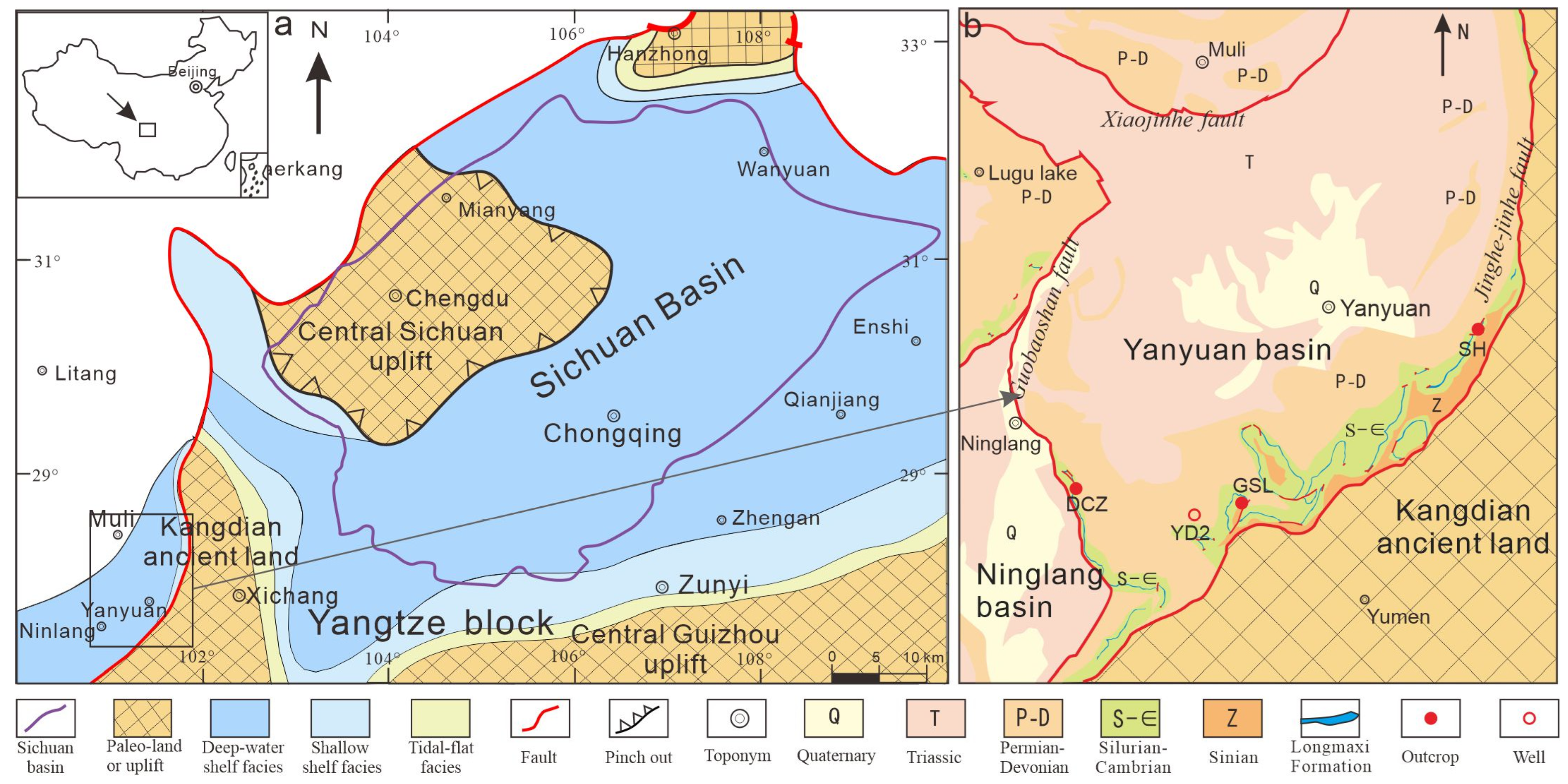

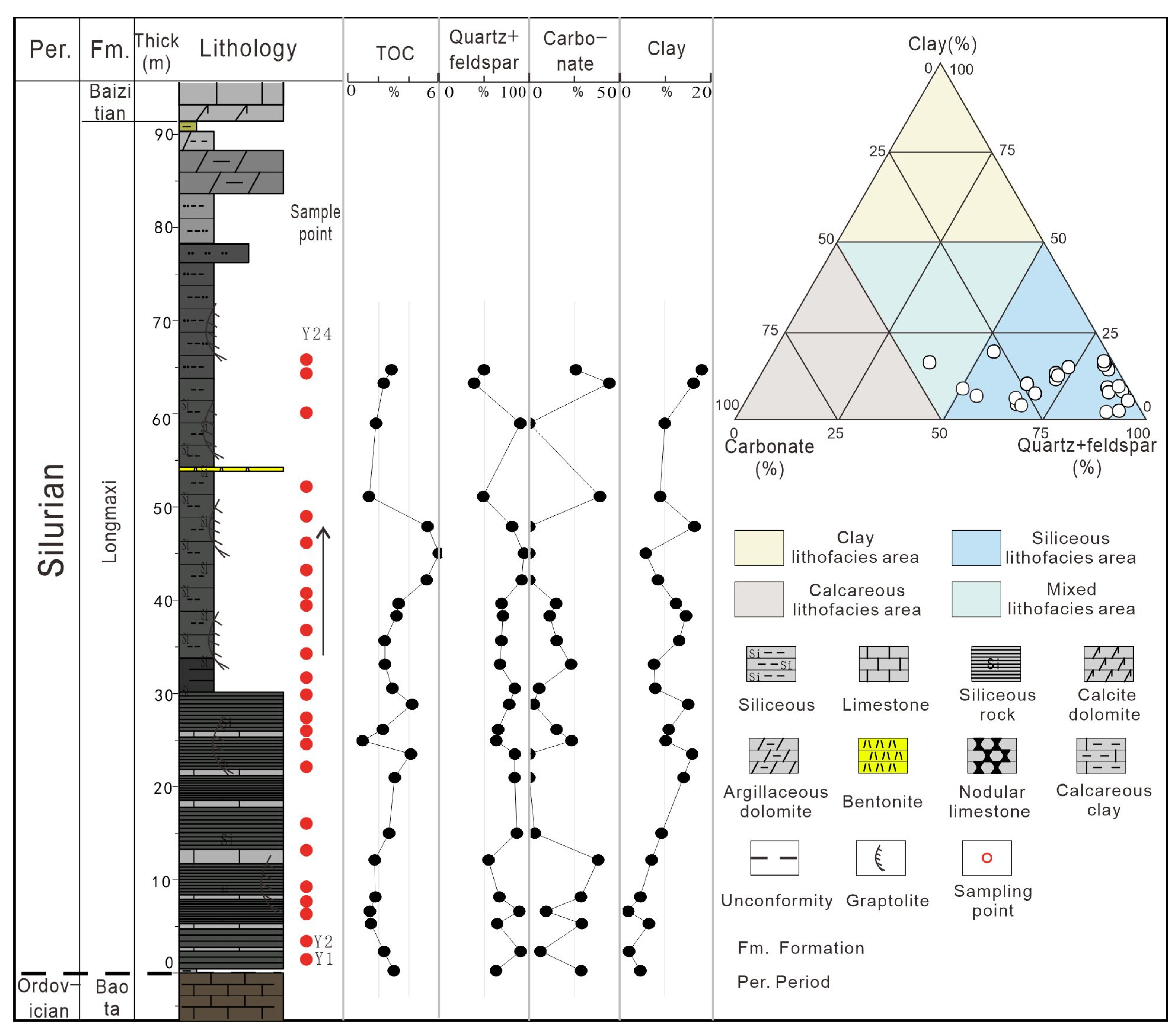
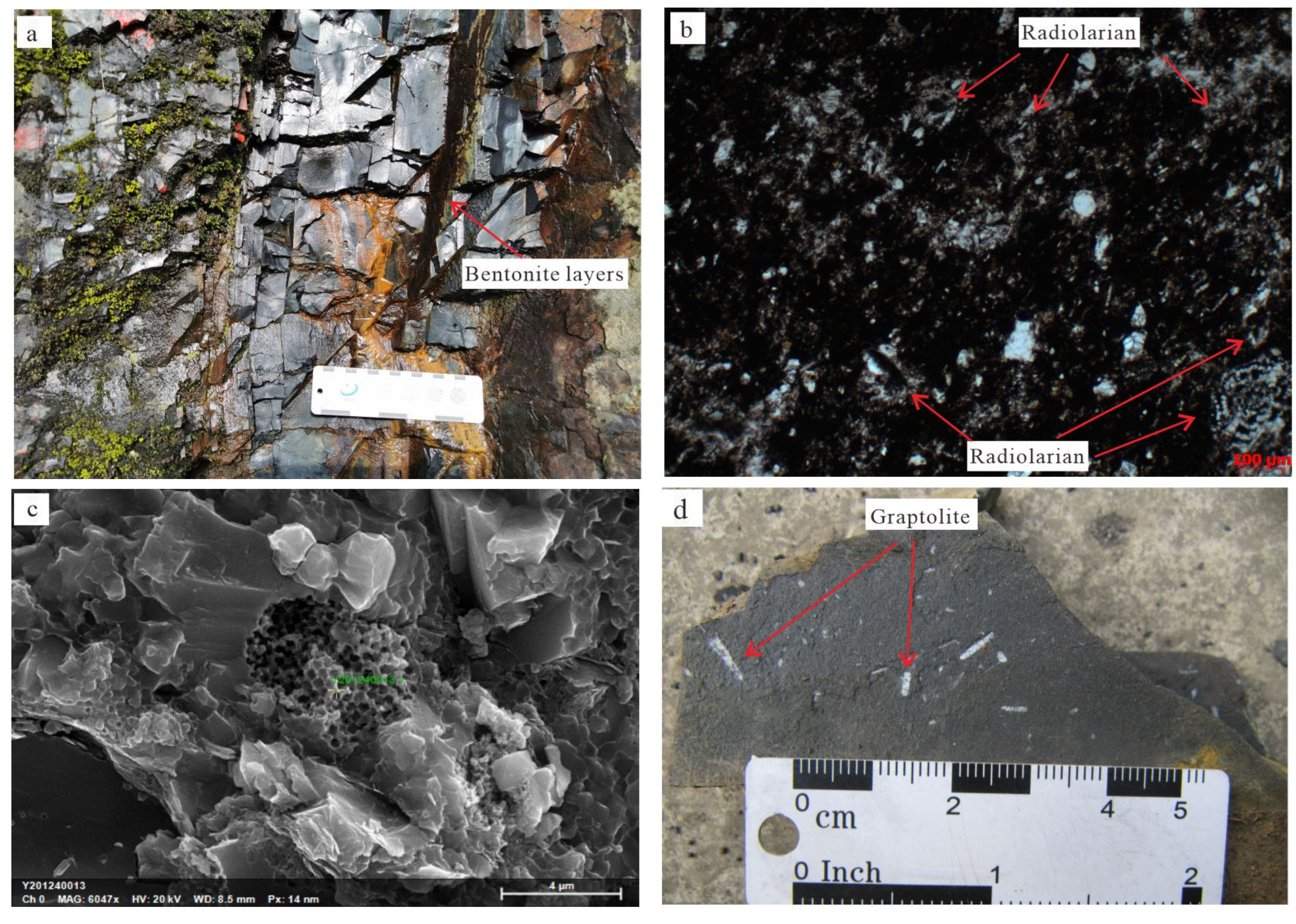

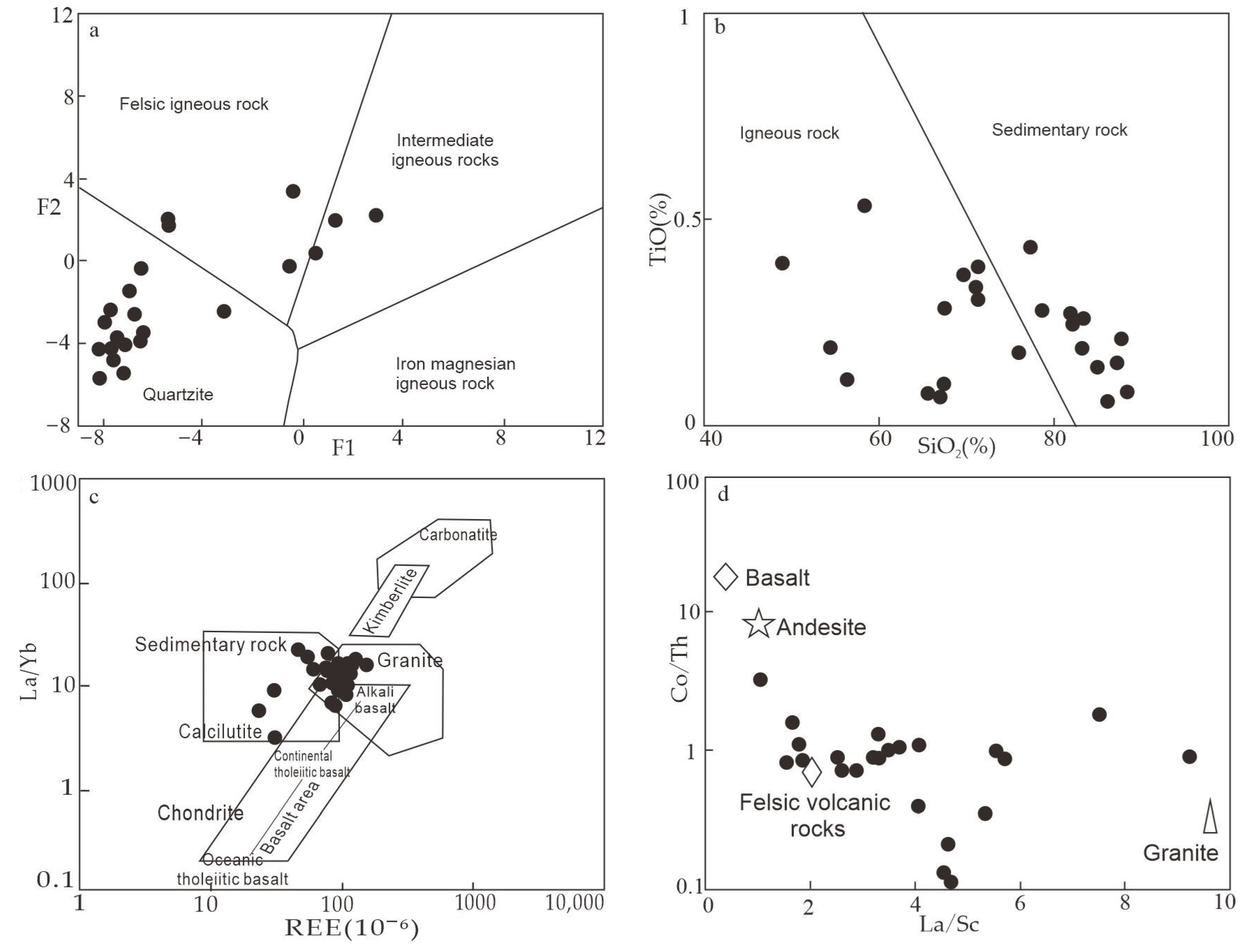
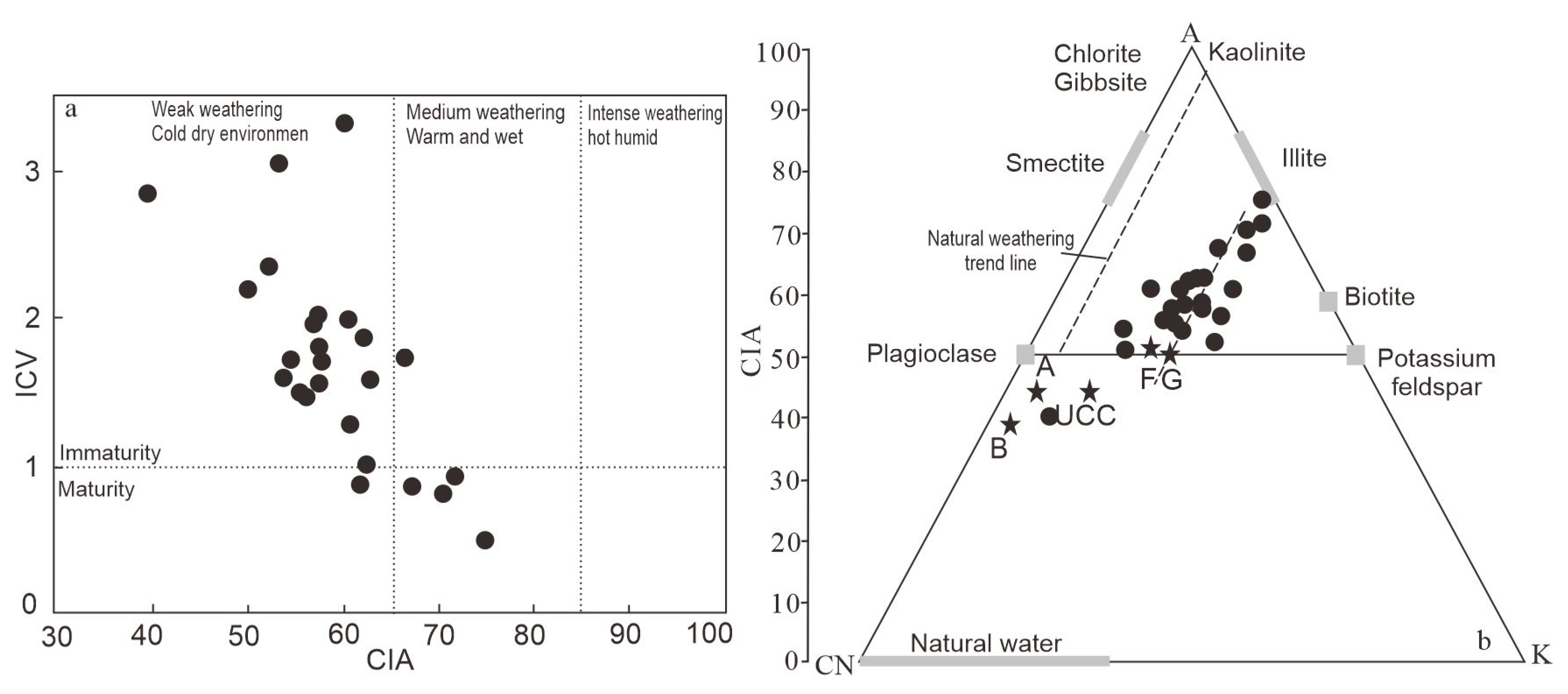
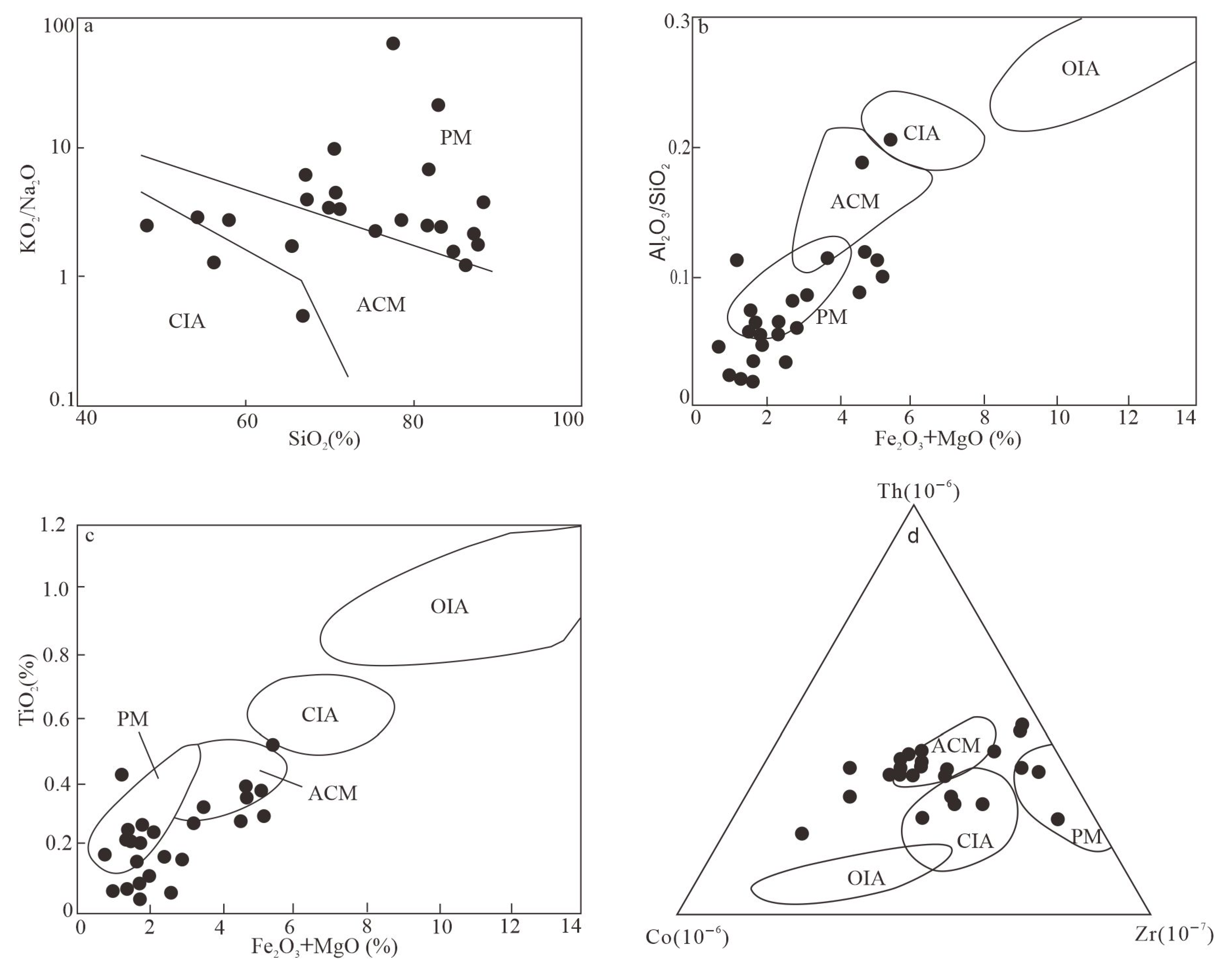
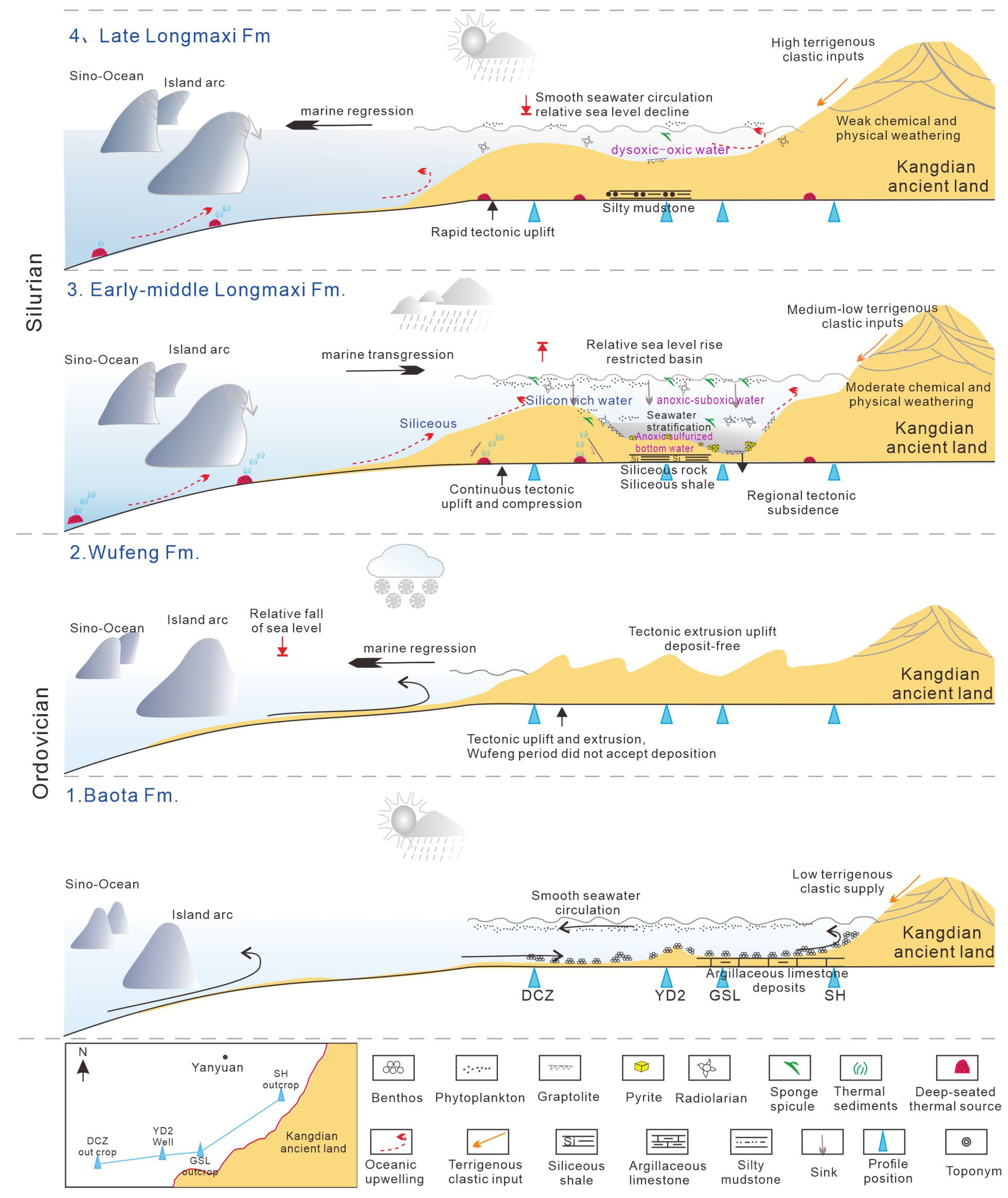
| Sample No. | Quartz | Potassium Feldspar | Plagioclase | Calcite | Dolomite | Pyrite | Clay |
|---|---|---|---|---|---|---|---|
| Y1 | 61.8 | 1.4 | 26.2 | 2.5 | 4.6 | ||
| Y2 | 89.5 | 0.8 | 2.7 | 3.5 | 2.1 | ||
| Y3 | 62.7 | 1.7 | 25.9 | 3.2 | 6.5 | ||
| Y4 | 88.8 | 4.5 | 4.8 | 1.9 | |||
| Y5 | 64.4 | 2.4 | 19.8 | 8.8 | 4.6 | ||
| Y6 | 49.4 | 5.4 | 36.5 | 1.6 | 7.1 | ||
| Y7 | 80.9 | 1.3 | 4.0 | 0.7 | 2.3 | 1.5 | 9.3 |
| Y8 | 77.0 | 1.7 | 5.0 | 2.1 | 14.2 | ||
| Y9 | 76.4 | 2.8 | 4.7 | 16.1 | |||
| Y10 | 50.1 | 9.7 | 3.6 | 9.9 | 13.5 | 3.0 | 10.2 |
| Y11 | 48.1 | 12.0 | 5.4 | 7.5 | 7.6 | 2.9 | 10.9 |
| Y12 | 70.5 | 1.7 | 5.5 | 1.0 | 1.5 | 4.6 | 15.2 |
| Y13 | 78.2 | 1.7 | 4.0 | 1.3 | 4.1 | 2.8 | 7.9 |
| Y14 | 62.5 | 1.5 | 3.6 | 11.2 | 11.9 | 1.7 | 7.6 |
| Y15 | 52.9 | 10.5 | 5.7 | 1.5 | 13.7 | 2.5 | 13.2 |
| Y16 | 56.8 | 6.8 | 7.1 | 11.3 | 3.3 | 14.7 | |
| Y17 | 60.3 | 3.9 | 5.0 | 1.9 | 13.0 | 3.4 | 12.5 |
| Y18 | 81.0 | 2.1 | 8.4 | 8.5 | |||
| Y19 | 88.3 | 1.5 | 4.4 | 5.8 | |||
| Y20 | 68.1 | 2.6 | 10.2 | 16.6 | |||
| Y21 | 42.8 | 2.4 | 3.7 | 30.1 | 9.0 | 3.0 | 9.0 |
| Y22 | 82.1 | 1.7 | 6.2 | 10.0 | |||
| Y23 | 27.1 | 3.2 | 8.5 | 24.7 | 19.6 | 16.4 | |
| Y24 | 33.5 | 4.2 | 12.1 | 5.2 | 20.6 | 18.2 | |
| average value | 64.7 | 3.7 | 5.6 | 12.4 | 8.5 | 2.8 | 10.1 |
| Sample | TOC | SiO2 | Al2O3 | Fe2O3 | CaO | MgO | K2O | Na2O | TiO2 | P2O5 | MnO | L.O.I | ICV | CIA |
|---|---|---|---|---|---|---|---|---|---|---|---|---|---|---|
| Y1 | 2.99 | 67.30 | 2.10 | 1.30 | 12.89 | 0.37 | 0.83 | 0.14 | 0.10 | 0.06 | 0.63 | 13.48 | 1.98 | 61 |
| Y2 | 2.34 | 88.26 | 1.71 | 0.65 | 1.84 | 0.63 | 0.54 | 0.14 | 0.07 | 0.04 | 0.05 | 4.81 | 1.89 | 62 |
| Y3 | 1.47 | 66.83 | 1.45 | 0.58 | 14.90 | 0.50 | 0.30 | 0.57 | 0.06 | 0.13 | 0.15 | 13.71 | 2.86 | 40 |
| Y4 | 1.40 | 86.22 | 1.39 | 0.75 | 3.79 | 0.96 | 0.32 | 0.26 | 0.05 | 0.04 | 0.05 | 5.89 | 3.07 | 54 |
| Y5 | 1.76 | 65.86 | 2.13 | 0.64 | 12.57 | 1.96 | 0.47 | 0.27 | 0.07 | 0.07 | 0.14 | 15.05 | 3.33 | 60 |
| Y6 | 1.72 | 56.24 | 2.80 | 1.16 | 18.77 | 0.88 | 0.78 | 0.58 | 0.11 | 0.04 | 0.26 | 17.78 | 2.23 | 50 |
| Y7 | 2.68 | 87.25 | 3.46 | 1.27 | 0.95 | 0.54 | 1.04 | 0.50 | 0.15 | 0.06 | 0.02 | 4.94 | 1.50 | 56 |
| Y8 | 3.05 | 83.25 | 5.30 | 1.90 | 0.17 | 0.52 | 1.70 | 0.08 | 0.25 | 0.07 | 0.01 | 5.86 | 0.94 | 72 |
| Y9 | 4.12 | 82.02 | 5.93 | 1.12 | 0.07 | 0.49 | 1.67 | 0.66 | 0.25 | 0.06 | 0.00 | 6.87 | 0.87 | 67 |
| Y10 | 0.91 | 67.33 | 5.82 | 1.95 | 7.40 | 2.59 | 2.82 | 0.70 | 0.28 | 0.07 | 0.12 | 10.05 | 2.36 | 52 |
| Y11 | 2.26 | 71.00 | 8.04 | 2.27 | 4.30 | 1.43 | 3.49 | 0.77 | 0.33 | 0.08 | 0.06 | 8.24 | 1.48 | 56 |
| Y12 | 4.21 | 78.74 | 6.62 | 2.31 | 0.85 | 0.89 | 1.85 | 0.69 | 0.28 | 0.10 | 0.02 | 7.29 | 1.27 | 61 |
| Y13 | 2.89 | 83.31 | 4.25 | 1.46 | 1.32 | 0.94 | 1.30 | 0.53 | 0.18 | 0.07 | 0.02 | 5.79 | 1.59 | 57 |
| Y14 | 2.40 | 75.82 | 4.44 | 1.18 | 5.31 | 1.68 | 1.34 | 0.58 | 0.17 | 0.07 | 0.07 | 8.82 | 1.96 | 57 |
| Y15 | 2.38 | 69.78 | 8.27 | 2.39 | 3.27 | 2.38 | 3.00 | 0.86 | 0.36 | 0.09 | 0.06 | 8.33 | 1.72 | 58 |
| Y16 | 3.17 | 71.04 | 7.97 | 2.62 | 2.98 | 2.47 | 2.84 | 0.86 | 0.38 | 0.12 | 0.05 | 8.92 | 1.81 | 57 |
| Y17 | 3.31 | 71.09 | 7.04 | 2.62 | 3.35 | 2.55 | 2.52 | 0.26 | 0.31 | 0.09 | 0.05 | 9.80 | 1.74 | 66 |
| Y18 | 5.17 | 81.94 | 5.26 | 1.37 | 0.11 | 0.38 | 1.61 | 0.24 | 0.26 | 0.06 | 0.00 | 7.68 | 0.83 | 71 |
| Y19 | 5.98 | 84.82 | 3.77 | 0.59 | 0.13 | 0.16 | 1.05 | 0.65 | 0.14 | 0.04 | 0.00 | 7.83 | 0.88 | 62 |
| Y20 | 5.23 | 77.45 | 8.71 | 1.19 | 0.25 | 0.07 | 2.55 | 0.04 | 0.43 | 0.06 | 0.00 | 8.66 | 0.50 | 75 |
| Y21 | 1.34 | 54.40 | 4.24 | 1.20 | 18.03 | 1.66 | 1.39 | 0.49 | 0.18 | 0.06 | 0.16 | 17.20 | 2.02 | 58 |
| Y22 | 1.81 | 87.66 | 4.53 | 1.44 | 0.12 | 0.24 | 1.35 | 0.73 | 0.21 | 0.05 | 0.01 | 3.64 | 1.01 | 62 |
| Y23 | 2.32 | 48.57 | 9.12 | 2.47 | 14.27 | 2.30 | 3.16 | 1.26 | 0.39 | 0.11 | 0.07 | 17.75 | 1.71 | 55 |
| Y24 | 2.83 | 58.26 | 12.02 | 3.16 | 5.04 | 2.34 | 4.48 | 1.66 | 0.53 | 0.36 | 0.06 | 11.37 | 1.59 | 54 |
| average value | 2.82 | 73.52 | 5.27 | 1.57 | 5.53 | 1.21 | 1.77 | 0.56 | 0.23 | 0.08 | 0.09 | 9.57 | 1.71 | 59.20 |
| Sample | Mo | Sb | Ba | As | Sr | Sc | Co | Th | U | Cr | ΣREE | LREE | HREE | LREE/HREE | δEu | δCe | LaN/YbN | Th/U |
|---|---|---|---|---|---|---|---|---|---|---|---|---|---|---|---|---|---|---|
| Y1 | 17 | 6.02 | 7445 | 7.67 | 70.3 | 3.18 | 7.32 | 2.24 | 7.67 | 61.5 | 30.50 | 22.33 | 8.17 | 2.73 | 0.85 | 0.85 | 0.25 | 0.29 |
| Y2 | 22.2 | 0.83 | 6559 | 5.3 | 91.4 | 1.95 | 1.6 | 1.95 | 5.3 | 29.5 | 24.13 | 19.66 | 4.47 | 4.40 | 1.44 | 0.86 | 0.52 | 0.37 |
| Y3 | 11.2 | 0.75 | 378 | 5.83 | 237 | 2.66 | 1.93 | 2.04 | 5.83 | 16.2 | 99.47 | 86.44 | 13.03 | 6.63 | 0.79 | 0.79 | 1.21 | 0.35 |
| Y4 | 12.7 | 0.77 | 926 | 4.26 | 51.1 | 1.97 | 1.97 | 1.52 | 4.26 | 18.9 | 32.11 | 27.13 | 4.98 | 5.45 | 1.32 | 0.85 | 0.84 | 0.36 |
| Y5 | 10.4 | 1.1 | 789 | 5.08 | 209 | 3.8 | 2.34 | 2.32 | 5.08 | 18.7 | 85.45 | 74.47 | 10.98 | 6.78 | 0.82 | 0.79 | 1.21 | 0.46 |
| Y6 | 18.2 | 1.63 | 881 | 4.66 | 206 | 3.37 | 5.49 | 3.07 | 4.66 | 22.4 | 98.83 | 87.86 | 10.97 | 8.01 | 0.76 | 0.78 | 1.46 | 0.66 |
| Y7 | 14 | 1.56 | 1261 | 3.37 | 46.2 | 3.81 | 3.97 | 3.92 | 3.37 | 37.8 | 61.41 | 54.30 | 7.11 | 7.64 | 0.95 | 0.85 | 1.35 | 1.16 |
| Y8 | 17.2 | 2.2 | 1793 | 4.26 | 27.9 | 4.98 | 4.53 | 6.17 | 4.26 | 49.7 | 68.53 | 60.73 | 7.80 | 7.79 | 0.78 | 0.86 | 1.18 | 1.45 |
| Y9 | 18.2 | 1.52 | 2262 | 3.37 | 33.5 | 4.24 | 0.78 | 7.06 | 3.37 | 72.9 | 82.96 | 76.48 | 6.48 | 11.80 | 0.91 | 0.86 | 1.79 | 2.09 |
| Y10 | 6.74 | 1.54 | 2046 | 3.66 | 240 | 5.42 | 2.98 | 7.31 | 3.66 | 27.9 | 110.87 | 95.99 | 14.88 | 6.45 | 0.68 | 0.89 | 0.88 | 2.00 |
| Y11 | 13.7 | 1.8 | 5745 | 6.45 | 108 | 6.63 | 6.63 | 7.4 | 6.45 | 53.2 | 96.59 | 83.10 | 13.49 | 6.16 | 0.75 | 0.90 | 0.76 | 1.15 |
| Y12 | 28.6 | 2.15 | 1920 | 6.99 | 40.6 | 5.88 | 8.52 | 7.55 | 6.99 | 73.6 | 110.08 | 97.98 | 12.10 | 8.10 | 0.77 | 0.85 | 1.43 | 1.08 |
| Y13 | 14.8 | 1.41 | 1725 | 3.98 | 50.9 | 4.32 | 4.61 | 5.19 | 3.98 | 45.8 | 69.01 | 60.68 | 8.33 | 7.28 | 0.90 | 0.85 | 1.19 | 1.30 |
| Y14 | 10.2 | 1.48 | 2468 | 3.38 | 77.2 | 3.85 | 4.99 | 4.66 | 3.38 | 27.3 | 69.77 | 60.67 | 9.10 | 6.67 | 0.84 | 0.85 | 1.05 | 1.38 |
| Y15 | 12.3 | 1.68 | 3334 | 4.07 | 89.6 | 6.32 | 6.78 | 7.56 | 4.07 | 69.6 | 106.00 | 92.68 | 13.32 | 6.96 | 0.66 | 0.88 | 1.01 | 1.86 |
| Y16 | 21.9 | 2.61 | 8373 | 6.17 | 79.7 | 7.53 | 7.39 | 6.51 | 6.17 | 96.1 | 90.32 | 75.75 | 14.57 | 5.20 | 0.67 | 0.93 | 0.60 | 1.06 |
| Y17 | 23.3 | 2.57 | 9082 | 6.4 | 92.5 | 7.42 | 8.55 | 5.21 | 6.4 | 68.3 | 83.83 | 70.93 | 12.90 | 5.50 | 0.71 | 0.93 | 0.62 | 0.81 |
| Y18 | 36.3 | 3.09 | 1546 | 5.11 | 28.1 | 3.98 | 1.68 | 4.54 | 5.11 | 64.7 | 82.67 | 75.74 | 6.93 | 10.93 | 0.78 | 0.84 | 1.78 | 0.89 |
| Y19 | 13.7 | 1.32 | 990 | 3.98 | 26.6 | 2.95 | 0.43 | 3.27 | 3.98 | 40.3 | 54.12 | 49.59 | 4.53 | 10.95 | 1.20 | 0.87 | 1.68 | 0.82 |
| Y20 | 25.4 | 1.71 | 3557 | 4.98 | 34.4 | 6.74 | 1.2 | 5.62 | 4.98 | 83.5 | 129.15 | 117.41 | 11.74 | 10.00 | 0.68 | 0.87 | 1.54 | 1.13 |
| Y21 | 7.78 | 1.08 | 1554 | 2.99 | 291 | 4.76 | 4.33 | 4.84 | 2.99 | 26.4 | 116.49 | 102.94 | 13.55 | 7.60 | 0.69 | 0.83 | 1.40 | 1.62 |
| Y22 | 11.1 | 1.44 | 2799 | 2.68 | 32.1 | 4.07 | 3.2 | 4.05 | 2.68 | 39.1 | 47.85 | 44.05 | 3.80 | 11.60 | 1.04 | 0.92 | 1.98 | 1.51 |
| Y23 | 11.1 | 1.54 | 1483 | 7.6 | 137 | 8.65 | 9.25 | 9.27 | 7.6 | 60.5 | 152.83 | 137.42 | 15.41 | 8.92 | 0.64 | 0.96 | 1.41 | 1.22 |
| Y24 | 2.29 | 1.02 | 2828 | 4.25 | 68.3 | 11.6 | 7.97 | 9.67 | 4.25 | 98.8 | 92.44 | 80.54 | 11.90 | 6.77 | 0.78 | 0.89 | 0.86 | 2.28 |
| average value | 15.85 | 1.78 | 2989 | 4.85 | 98.68 | 5.00 | 4.52 | 5.12 | 4.85 | 50 | 83.14 | 73.12 | 10.02 | 7.51 | 0.85 | 0.86 | 1.17 | 1.14 |
| UCC | 1.50 | 0.20 | 550 | 1.50 | 350.00 | 11.00 | 10.00 | 10.70 | 2.80 | 35 | ||||||||
| EF | 30.44 | 25.70 | 16 | 15.57 | 0.81 | 1.31 | 1.30 | 1.38 | 4.99 | 4 |
Disclaimer/Publisher’s Note: The statements, opinions and data contained in all publications are solely those of the individual author(s) and contributor(s) and not of MDPI and/or the editor(s). MDPI and/or the editor(s) disclaim responsibility for any injury to people or property resulting from any ideas, methods, instructions or products referred to in the content. |
© 2023 by the authors. Licensee MDPI, Basel, Switzerland. This article is an open access article distributed under the terms and conditions of the Creative Commons Attribution (CC BY) license (https://creativecommons.org/licenses/by/4.0/).
Share and Cite
Zhang, Q.; Zhang, B.; Yu, Q.; Men, Y.; Zhang, H.; Kang, J.; Cao, J.; Zhao, A.; Zhou, Y.; Feng, X. Study on the Provenance and Tectonic Setting of Mudstone in the Lower Silurian Longmaxi Formation of the Yanyuan Basin on the Western Margin of the Yangtze Platform. Minerals 2023, 13, 194. https://doi.org/10.3390/min13020194
Zhang Q, Zhang B, Yu Q, Men Y, Zhang H, Kang J, Cao J, Zhao A, Zhou Y, Feng X. Study on the Provenance and Tectonic Setting of Mudstone in the Lower Silurian Longmaxi Formation of the Yanyuan Basin on the Western Margin of the Yangtze Platform. Minerals. 2023; 13(2):194. https://doi.org/10.3390/min13020194
Chicago/Turabian StyleZhang, Qian, Bin Zhang, Qian Yu, Yupeng Men, Haiquan Zhang, Jianwei Kang, Junfeng Cao, Ankun Zhao, Yexin Zhou, and Xintao Feng. 2023. "Study on the Provenance and Tectonic Setting of Mudstone in the Lower Silurian Longmaxi Formation of the Yanyuan Basin on the Western Margin of the Yangtze Platform" Minerals 13, no. 2: 194. https://doi.org/10.3390/min13020194
APA StyleZhang, Q., Zhang, B., Yu, Q., Men, Y., Zhang, H., Kang, J., Cao, J., Zhao, A., Zhou, Y., & Feng, X. (2023). Study on the Provenance and Tectonic Setting of Mudstone in the Lower Silurian Longmaxi Formation of the Yanyuan Basin on the Western Margin of the Yangtze Platform. Minerals, 13(2), 194. https://doi.org/10.3390/min13020194





